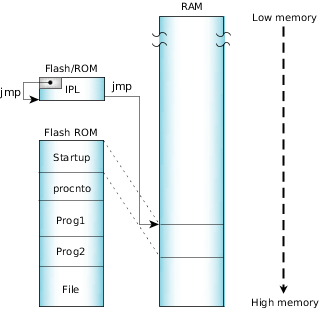This is the simplest scenario. In this case, the entire image is stored in some form of directly addressable storage — either a ROM device or a form of PC-Card device that maps its entire address space into the processor's address space. All that's required is to copy the startup code into RAM. This is ideal for small or deeply embedded systems.
Note that on x86 architectures, the device isn't required to be addressable within the first megabyte of memory. The startup program also needn't be in the first megabyte of RAM.
Note also that for PC-Card devices, some form of setup may be required before the entire PC-Card device's address space will appear in the address space of the processor. It's up to your IPL code to perform this setup operation. (We provide library routines for several standard PC-Card interface chips.)
 Figure 1. Linearly mapped device.
Figure 1. Linearly mapped device.